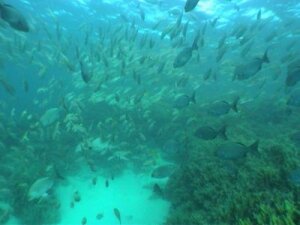|
The Northwestern Hawaiian Islands and the reefs that surround them provide us with a chance to see what ecosystems in the throughout the Hawaiian Islands may have looked like before the arrival of human beings more than 1500 years ago. A number of unique species of corals, marine invertebrates, algae, and sea grasses, fishes, sea turtles, and marine mammals all make the reefs NWHI their homes. The islands are also home to rare and endangered plants and insects.

The small islands in the NWHI make a vital habitat for breeding and nesting for more than 14 million seabirds. Nearly all of the world's population of Laysan Albatross return each year to the NWHI. More than 9 out of 10 of the Hawaiian population of the Hawaiian Green Sea Turtles nest at the French Frigate Shoals. Occasionally, other species of sea turtles visit the NWHI as well.
The NWHI is also home to the endangered Hawaiian Monk Seal. The majority of the population of 1,400 seals rely on the protected isles and reefs for food and breeding grounds.
Other marine mammals like Humpback Whales travel though the NWHI on their yearly migrations. The reefs of the NWHI are much more diverse than those found in the Main Hawaiian Islands. Of the more than 7,000 different species that have been recorded in the Hawaiian Islands, more than half are only found in the NWHI. While the Northwestern Hawaiian Islands are remote, the evidence of humanity's impact is painfully obvious.
|

